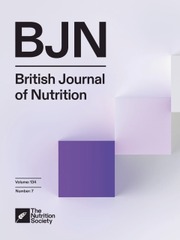No CrossRef data available.
Relationships between iodine nutrition status, and bone mineral density and bone metabolism: a cross-sectional study of 1207 thyroid disease-free adults in China
Published online by Cambridge University Press: 10 April 2025
Abstract
Little is known about the association between iodine nutrition status and bone health. The present study aimed to explore the connection between iodine nutrition status, bone metabolism parameters, and bone disease (osteopenia and osteoporosis). A cross-sectional survey was conducted involving 391, 395, and 421 adults from iodine fortification areas (IFA), iodine adequate areas (IAA), and iodine excess areas (IEA) of China. Iodine nutrition status, bone metabolism parameters and BMD were measured. Our results showed that, in IEA, the urine iodine concentrations (UIC) and serum iodine concentrations (SIC) were significantly higher than in IAA. BMD and Ca2+ levels were significantly different under different iodine nutrition levels and the BMD were negatively correlated with UIC and SIC. Univariate linear regression showed that gender, age, BMI, menopausal status, smoking status, alcohol consumption, UIC, SIC, free thyroxine, TSH, and alkaline phosphatase were associated with BMD. The prevalence of osteopenia was significantly increased in IEA, UIC ≥ 300µg/L and SIC > 90µg/L groups. UIC ≥ 300µg/L and SIC > 90µg/L were risk factors for BMD T value < -1.0 SD. In conclusion, excess iodine can not only lead to changes in bone metabolism parameters and BMD, but is also a risk factor for osteopenia and osteoporosis.
- Type
- Research Article
- Information
- Copyright
- © The Author(s), 2025. Published by Cambridge University Press on behalf of The Nutrition Society
Footnotes
Zheng Zhou and Jinjin Liu have contributed equally to this work and share first authorship


